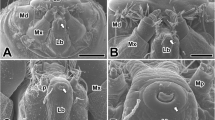Summary
Actively secreting silk gland cells of caddis fly larvae show the following fine structure: a well developed rough-surfaced endoplasmic reticulum, continuity between roughsurfaced and smooth-surfaced endoplasmic reticulum adjacent to the Golgi saccules, dense material (secretion) in the margins of the Golgi saccules, some of which appear in the form of blebs and discrete membane bounded secretion granules; the latter seem to coalesce and migrate to the surface of the cell where they are discharged. Intracisternal granules appear in glands where the secretion cycle has apparently been interrupted. These observations suggest a secretion cycle for the silk glands comparable to that demonstrated by both morphological and experimental methods in certain other protein secreting cells: namely, synthesis by the ribosomes, transport to the Golgi complex through the cisternae of the endoplasmic reticulum, concentration by the Golgi complex and movement of the secretion granules through the cytoplasm to the surface of the cell where they are discharged.
Similar content being viewed by others
References
Beams, H. W., and C. F. Wu: Cytological studies on the spinning glands of Platyphylax designatus Walker (Trichoptera): respective roles played by the nucleus and the Golgi apparatus during secretion. J. Morph. Physiol. 47, 261–281 (1929).
Bruni, C., and K. R. Porter: The fine structure of the parenchymal cell of the normal rat liver. I. General observations. Amer. J. Path. 46, 691–755 (1965).
Caro, L. G.: Electron microscopic radioautography of thin sections: the Golgi zone as a site of protein concentration in pancreatic acinar cells. J. biophys. biochem. Cytol. 10, 37–45 (1961).
—, and G. E. Palade: Protein synthesis, storage, and discharge in the pancreatic exocrine cell. An autoradiographic study. J. Cell Biol. 20, 473–495 (1964).
Ho, C. P., S. M. Shen, P. S. Tang, and S. H. Yü: Physiology of the silkworm. II. Mechanism of silk formation as revealed by x-ray analyses of the contents of the silk gland in Bombyx mori. Physiol. Zool. 17, 78–82 (1944).
Jamieson, J. D., and G. E. Palade: Intracellular transport of newly synthesized proteins in the exocrine pancreas. J. Cell Biol. 27, 47 A (1965).
Karnowska-Gorska, Z.: Quelques observations sur la glands séricigène de Bombyx mori L. au moyen du microscope électronique. Cellule 61, 59–66 (1960).
Kinney, E.: A cytological study of secretory phenomena in the silk gland of Hyphantria cunea. Biol. Bull. 51, 405–433 (1926).
Kurosumi, K.: Golgi apparatus and its derivatives, with special references to secretory granules. In: Intracelullar membraneous structure (ed. S. Seno and E. V. Cowdry), p. 259–276. Okayama, Japan: Symp. Soc. Cell Chem., Suppl. 1963.
Luft, J. H.: Improvements in epoxy resin embedding methods. J. biophys. biochem. Cytol. 9, 409–414 (1961).
Marshall, W. S., and C. T. Vorhies: Cytological studies on the spinning glands of Platyphylax designatus Walker (Phryganid). Int. Mschr. Anat. Physiol. 23, 397–420 (1906).
Maziarski, S.: Recherches cytologiques sur les phénomènes sécrétoires dans les glandes filières des larves des Lépidoptères. Arch. Zellforsch. 6, 397–433 (1911).
Nakahara W.: Physiology of nucleoli as seen in silk gland cells of certain insects. J. Morph. 29, 55–73 (1917).
Novikoff, A. B., and W. Y. Shin: The endoplasmic reticulum in the Golgi zone and its relations to microbodies, Golgi apparatus and autophagic vacuoles in rat liver cells. J. Microscopie 3, 187–206 (1964).
Palade, G. E.: A study of fixation for electron microscopy. J. exp. Med. 95, 285–297 (1952).
—: Intracisternal granules in the exocrine cells of the pancreas. J. biophys. biochem. Cytol. 2, 417–422 (1956).
—: The secretory process of the pancreatic exocrine cell. In: Electron microscopy in anatomy (ed. J. D. Boyd, F. R. Johnson and J. D. Lever), p. 176–195. London: Edward Arnold, Ltd. 1961.
—, P. Siekevitz, and L. G. Caro: Structure, chemistry and function of the pancreatic exocrine cell. In: Ciba Foundation Symposium on the Exocrine Pancreas (ed. A. V. S. De Heuck and M. P. Cameron), p. 23–55. London: J. A. Churchill, Ltd. 1962.
Palay, S. L.: The morphology of secretion. In: Frontiers in cytology (ed. S. L. Palay), p. 305–342. New Haven: Yale University Press 1958.
Phillips, D. M., and H. Swift: Cytoplasmic fine structure of Sciara salivary glands. J. Cell Biol. 27, 395–410 (1965).
Reynolds E. S.: The use of lead citrate at high pH as an electron opaque stain in electron microscopy. J. Cell Biol. 17, 208–212 (1963).
Sabatini, D. D., K. Bensch, and R. J. Barrnett: Cytochemistry and electron microscopy. The preservation of cellular ultrastructure and enzymatic activity by aldehyde fixation. J. Cell Biol. 17, 19–58 (1963).
Siekevitz, P.: The cytological basis of protein synthesis. Exp. Cell Res., Suppl. 7, 90–110 (1959).
Voigt, W. H.: Zur funktionellen Morphologie der Fibroin- und Sericin-Sekretion der Scidendrüse von Bombyx mori L. I. Der proximale Abschnitt der Seidendrüse. Z. Zellforsch. 66, 548–570 (1965a).
—: Zur funktionellen Morphologie der Fibroin- und Sericin-Sekretion der Scidendrüse von Bombyx mori L. II. Der Mediale Abschnitt der Seidendrüse. Z. Zellforsch. 66, 571–582 (1965b).
Warshawsky, H., C. P. Leblond, and B. Droz: Synthesis and migration of proteins in the cells of the exocrine pancreas as revealed by specific activity determination from radioautographs. J. Cell Biol. 16, 1–23 (1963).
Watson, M. L.: Staining of tissue sections for electron microscopy with heavy metals. J. biophys. biochem. Cytol. 4, 475–485 (1958).
Wu, C. F.: Cytological studies on the spinning glands of the larva of Galleria mellonella: respective roles played by the nucleus, the Golgi apparatus, and the mitochondria during secretion. J. Morph. 49, 509–534 (1930).
Author information
Authors and Affiliations
Additional information
This research was supported by grants from the National Institutes of Health (RG-4706, 5479) and the National Science Foundation (G-9879).
Rights and permissions
About this article
Cite this article
Beams, H.W., Sekhon, S.S. Morphological studies on secretion in the silk glands of the caddis fly larvae, Platyphylax designatus walker. Zeitschrift für Zellforschung 72, 408–414 (1966). https://doi.org/10.1007/BF00341544
Received:
Issue Date:
DOI: https://doi.org/10.1007/BF00341544




